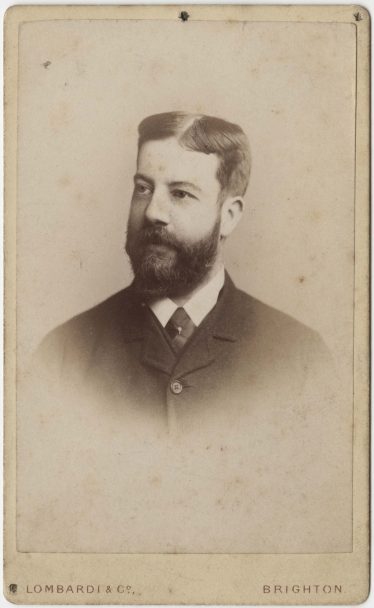
Henry Tylston Hodgson in 1882 – carte de visite
This account of the Hodgson family is drawn together from a number of sources:
- notes made by Eric Brandreth in the 1970s (LHS archives: RB Hodgson family);
- information from Tim Paine, curator of the Paine Family Tree – http://www.painefamily.co.uk/ (descendents of Henry Tylston Hodgson’s daughter, Mabel Beatrice Tylston Hodgson);
- illustrations from the family archives owned by Jenny Smith (granddaughter of Victor Tylston Hodgson);
- information from the Midland Railway Society about Henry Tylston Hodgson’s directorships, including research by Tony Overton – www.midlandrailwaystudycentre.org.uk
- and information from Mel Skeet, who has researched Aubrey Hodgson’s friendship with William Henderson Mackenzie at Achnacone House, Colchester – see Comment below.
We are grateful to all those who have given permission for the use of their research.
Ancestors
Henry Tylston Hodgson was born on 6 October 1843 at Kirby Frith in Leicestershire, and was educated at Harrow and Trinity College Cambridge.
His father, Isaac Hodgson (1783-1859), a banker and abolitionist, was the son of Thomas Hodgson (1738-1817) a cotton miller and slave trader of Caton, Lancashire. The story of Thomas Hodgson has been compiled by Tim Paine, and can be downloaded from the document appended at the foot of this page.
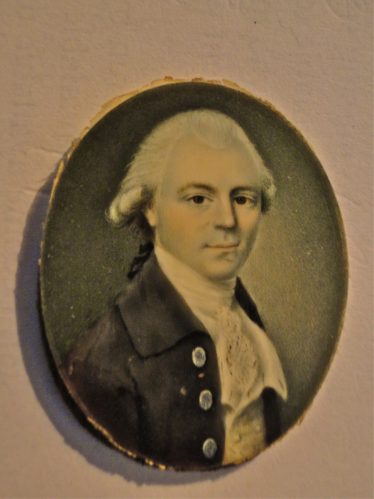
Thomas Hodgson (1738-1817) – sea captain, ship owner, trader in slaves and cotton
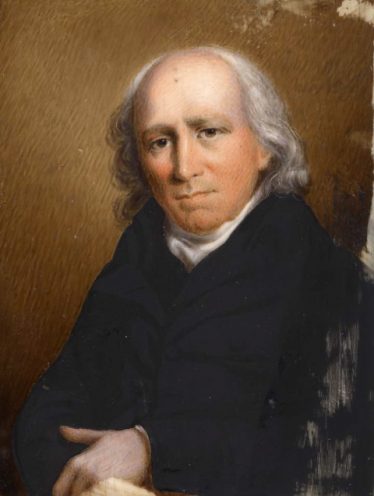
Thomas Hodgson as an older man, married to Elizabeth Lightbody, 20 years his junior
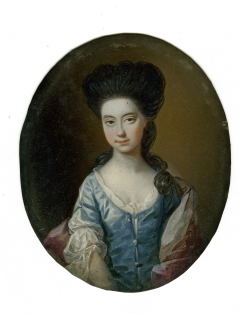
Elizabeth Hodgson, nee Lightbody (1758-1795) 1770s – before her marriage to Thomas Hodgson
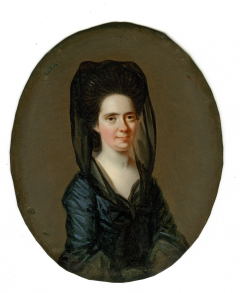
Elizabeth Lightbody nee Tylston (1735-1801)- Tylston c.1770s – Mother-in-law of Thomas Hodgson
The name Tylston came through Elizabeth Lightbody (1758-1795), the wife of his grandfather Thomas Hodgson. Elizabeth was the daughter of Elizabeth Tylston (1735-1801), whose grandfather Dr John Tylston (1664-1699), was a physician in Chester, known for his charitable treatment of the poor, and for his contributions to medical experiments and medical ethics. The family held this distinguished ancestor in great esteem and this may explain why they revived the name Tylston.
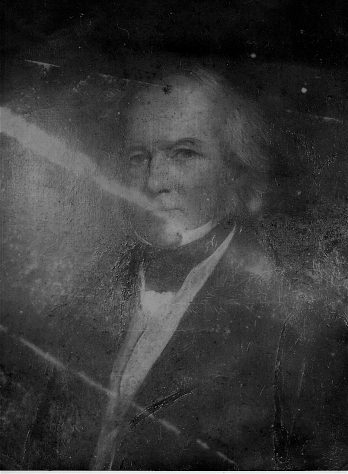
Isaac Hodgson – father of Henry Tylston Hodgson
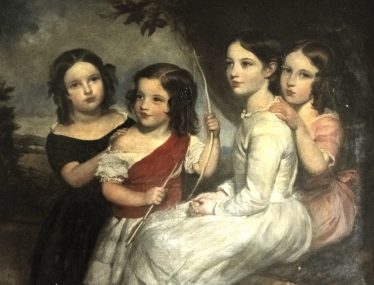
Henry (with bow and Arrow) and sisters, 1840s
Henry was Isaac Hodgson’s only surviving son; he had six sisters. His paternal uncle Adam (1789-1861) was also a banker and abolitionist and one of his father’s sisters, Mary Tylston Hodgson (1791-1850) carried the Tylston name, as did his cousin, Adam’s infant daughter, Elizabeth Tylston Hodgson (b. 1830). Nearly all of Henry’s children had Tylston as a middle name. Had Henry inherited wealth from his slave-owning grandfather? Was he honouring his father’s and uncle’s work as Abolitionists? He certainly seems to have settled in Harpenden with inherited wealth.
Marriage
Henry married Charlotte Purefoy Lloyd Warde in Harpenden on 25 August 1865. Their first child, Aubrey, was born on 20 April 1866 in Frankfurt-am-Main, probably prematurely, during an extended honeymoon. On their return to Harpenden, Aubrey was christened on 21 May 1866.
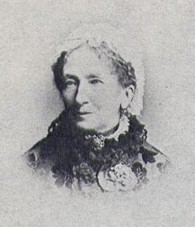
Marianne Warde nee Bennet-Lawes, 1813-1891
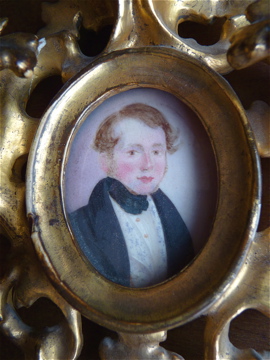
Charles Warde (1813 – 1863)
Charlotte was born on 9 February 1842 at Clopton, Stratford on Avon. Her parents were Charles Thomas Warde (1813-1865), of Welcombe, Warwickshire (of a family reputedly descended from Edward I) and Marianne (1813-1891), sister of Sir John Bennet Lawes, the founder of the Rothamsted Experimental Station. Charles and Marianne married in Harpenden parish church in 1834.
By 1847 Marianne Warde’s marriage had failed, since Charles had led a roguish life with mistresses and further children. The Clopton Hercules by Duncan Sprott tells Charles Warde’s story in a very scurrilous style.
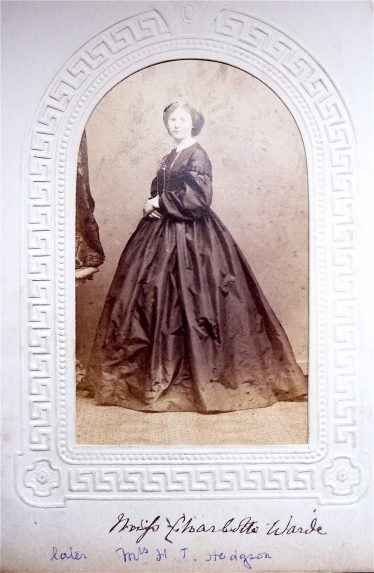
Charlotte Warde (1842-1910)
Marianne returned with her children to Rothamsted Manor or more probably to Rothamsted Lodge where her widowed mother, Marianne Bennet Lawes lived until her death in 1876. According to John Bennet Lawes’ diaries (in the Rothamsted archives), there were various court cases and it seems that by 1850 Marianne had obtained a ‘Lambeth’ or ecclesiastical divorce.
By the time of the 1851 census, Marianne had taken up residence at Bennetts, a house then belonging to the Rothamsted estate. In the 1861 census, Charlotte was living with her mother, two of her sisters and her brother at Bennetts. There is no record of how or where she met her future husband, who had no other ties with Harpenden.
Indeed, the first mention of Henry Tylston Hodgson in Harpenden local history records is when, in December 1866 at the aged of 23, he was elected to the Committee of the Harpenden Lecture Institute for 1867. In January 1868 he was made Vice-President in place of the Rector, Canon Vaughan (who took Henry’s place on the Committee) and he held this position until 1912 when the Institute (by then in premises he had provided in 1887) finally closed down.
Moving into Welcombe
An Indenture of Conveyance and Mortgage dated 24 December 1868 between Richard Oakley, Edward Manson and Adelaide Manson and Henry Tylston Hodgson deals with his purchase of Welcombe. Whether this was already the name of the property, or whether it was named after Charlotte’s father’s place of origin, Welcombe in Warwickshire is not known for certain. Documents and indentures refer to the “Mansion House messuages lands hereditaments and premises”.
In the 1871 Census, Henry was listed as the Head of Household at Welcombe, with his occupation described as landowner and MA of Cambridge. His sons Aubrey (4), Eustace Henry, born in 1870 and Gerald Augustus aged 3 months were listed along with a staff of seven, from Housekeeper to Kitchen maid and Footman (no mention of a butler).
A Director of the Midland Railway Company
Quite when and how Henry became associated with the Midland Railway Company, which opened the line through Harpenden to St Pancras in 1868, is not known, but by 1873, at the age of 30 he was elected a Director. The eastern border of the Welcombe estate ran alongside the railway. In 1904 he became Deputy Chairman, a post he still held when he died in 1918. Most probably he had invested in the company. By 1880 he was a member of the Carriage & Wagon, Finance, General Purposes, Locomotive, Parliamentary, St Pancras Hotel Matters, South Construction, Stores, Ashby & Nuneaton, North & Western Junction, Severn Bridge Board, and Tottenham & Hampstead Committees – enough to keep him busy with meetings in Derby. In 1885 he was a Midlands Railway representative at the International Railway Congress in Brussels.
In addition he was on the boards of several other railway companies. He was a director of the Midland and Great Northern Railway Company from 1891-1898 and again from 1914-1918. He represented the Midland Railway on the Board of the Glasgow and South Western Railway in 1892 until his death in 1918. In 1915 he was also a director of the Cheshire Lines Committee, the Somerset and Dorset Railway, The Great Central, Hull & Barnsley and Midland Joint Committee, The Great Central & Midland Joint Committee, The Whitechapel and Bow Railway and the Northern Counties Committee. In 1915 he was Chairman of the Mexican Eastern Railway and a director of the Inter Oceanic Railway of Mexico. No wonder that, at his death, his Harpenden physician, Dr Blake, thought “he was doing too much”.
He was also on the board of the London, Provincial and South Western Bank when it was formed out of the amalgamation of the London and Provincial Bank and the London and South Western Bank in December 1917. In 1918, presumably after his death, this bank was taken over by Barclays Bank. It seems likely that, in the steps of his father, he had banking interests throughout his career.
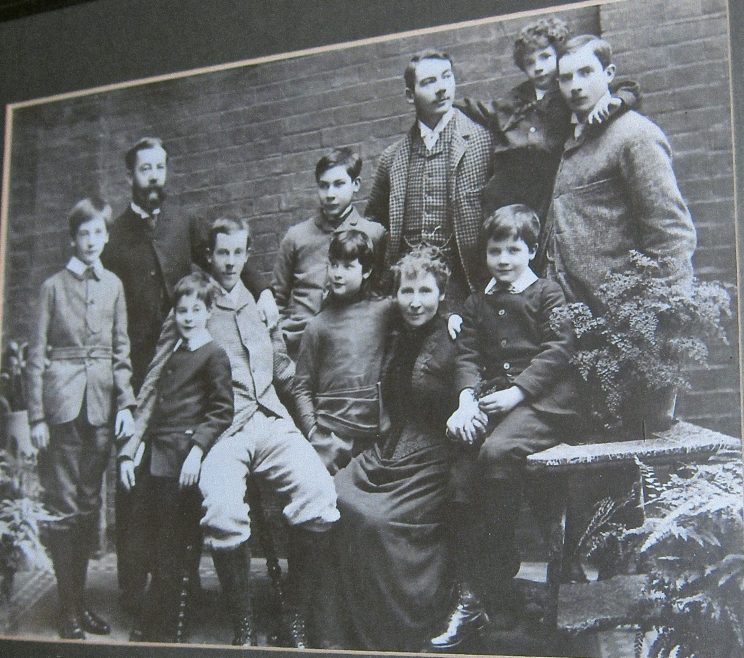
The Hodgson family at Welcombe in 1888/9. Aubrey is the chap in the check suit with Linnhe between him and Gerald. On Aubrey’s right is Ronald. Father, Henry Tylston Hodgson, is on the left, with Victor on his right. Eustace, in pale clothes, has ‘Bim’ (Hubert) leaning against him; on Eustace’s left is my grandmother, Mabel, with her arm round her mother, Charlotte, who has ‘Bom’ (Oswald) sitting on her left.
The family grew through the 1870s, with the birth of Ronald Tylston (1873-1901), Charles Victor Tylston on 3 July 1975, Mabel Beatrice Tylston on 15 April 1877, the twins Oswald Tylston and Hubert Mervyn on 1 January 1881 and Nigel Linnhe Tylston (1882-1909). At the 1881 Census, only Gerald and Ronald were listed at Welcome along with their governess and the staff including a butler, while Henry and Charlotte, Charles Victor, Mabel and the twins were registered in Eastbourne, along with nurses and a Swiss lady’s maid. Henry was described as a Magistrate on this Census.
A Lifetime of Public Service
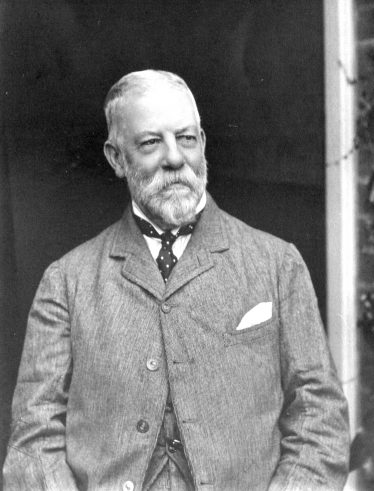
Henry Tylston Hodgson JP, c.1900
In fact Henry had become a Justice of the Peace in 1874 at the age of 31, and he sat regularly at the weekly courts held at St Albans. At the time of his death a tribute was paid to him, in which it was said that he was practically the senior member of the St Albans County Petty Sessions, only Mr H J Toulmin (living at Childwickbury from 1871-1883) having served longer.
At the age of 33, in 1876, he became a Churchwarden and served in this role for 28 years, until 1904. He was noted as a devoted son of the Church of England, and in his will he left various areas of land around the church to the church (St Nicholas). The Rector (presumably the Revd Pitt) was sure that one was intended for a meeting room, about which they had talked on occasions. Subsequently this land was used to provide a playground for St Nicholas Church of England Primary School.
Politics did not concern him greatly but he was a liberal of the Old School. After Gladstone’s Home Rule Bill he became a Liberal Unionist. In 1889, when Hertfordshire County Council was established, he was elected as Harpenden’s first County Councillor, and in 1903 he served as High Sherriff of the County. In November 1907, the County Council appointed him as their representative as a Foundation Manager for the Church of England schools in Harpenden (St Nicholas, St John’s and St Mary’s primary schools).
During the First World War he was a member of the Harpenden Military Service Tribunal when conscription was introduced in 1916. At his death in 1918, The Herts Advertiser reported that “his sagacity, wise counsel and judicial attitude will be greatly missed by that body.”
Generous benefactor
As well as these formal roles, Henry and his wife were involved in many local societies and activities, including the annual exhibitions of flowers, fruit, vegetables and honey of the Harpenden Horticultural Society. The parish magazine report of the 8th show on 25 August 1886 says: “Magnificent display of flowers, those which gained the prizes coming from the conservatories of Mr C R Fenwick, Sir J B Lawes [Rothamsted], Mrs Warde [Bennetts], Mr H T Hodgson, Mr J B Maple [Childwickbury] and Mr R Matter.” Note that the gentry received the credit, rather than their gardeners!
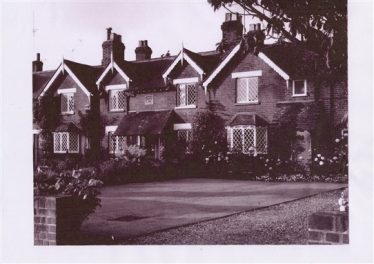
8-13 Southdown Road, Hodgson’s cottages, built 1870
Henry’s gifts of buildings to Harpenden included Hodgson’s cottages (8-11 Southdown Road), the Institute (1887, later to become The Friends Meeting House) in Southdown Road, The Welcombe Institute in Heath Road (premises used later by the Salvation Army and the Welcombe & Rovers Football Club, demolished in the late 1960s), St John’s Hall (now Harpenden Trust halls in Southdown Road), and the Rifle shooting range on his land behind 37 Southdown Road (later Harpenden 3rd Scout Hut). He was President of Harpenden Boy Scouts, Treasurer of the Horticultural Society, and was one of the Trustees of the Harpenden United Charities (in the Parish Magazine for January 1899 he gave an explanatory account of the charities).
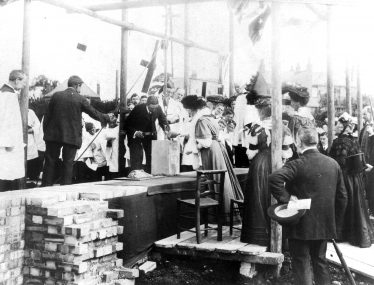
Mrs Hodgson laying the foundation stone of St John’s church
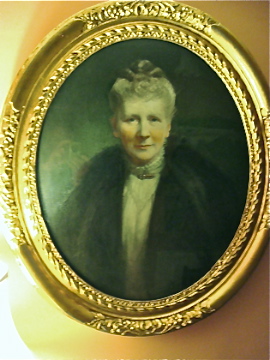
Charlotte Hodgson towards the end of her life
Mrs Hodgson founded the Harpenden Nursing Association, of which Henry was President. In July 1907 she laid the foundation stone of the new St John’s Church, which opened in March 1908. She had hosted many groups at Welcombe, including, on 12 July 1888, when the parish magazine reported “members of the Mothers’ Meeting for Cravells Road and Bowling Alley (conducted by Mrs Paterson and Mrs Warington) were entertained with tea and music at Mrs Hodgson’s own house. The large party was amused by Mrs Hodgson, her children and friends, with songs and dramatic performances to their great delight.”
The Hodgson family of eight boys and one girl were also known for their Saturday hockey matches at Welcombe, about 30 people joining in, with Mr Hodgson keeping goal at one end. Tea was “bounteous” – hot scones, potato cakes, chocolate cake etc. The family entertained generously, according to reminiscences in the Free Press (1964) by Philip Bentley, son of Harry Bentley, the Hodgson’s butler from 1890 to 1918. Philip’s mother had been a housemaid, and the Bentleys appear to have lived in one of the Hodgson cottages (Kelly’ directories from 1901-1922).
There is evidence of loyalty to and by servants. Mary Lakin, the Housekeeper in the 1871 Census, is described as “Old Domestic Servant” in the 1881 Census. The inscriptions on two monuments in the churchyard (as recorded in the 1970s) celebrate life-long service: Marie Lenaiaebi, born in Canton Bern, Switzerland on 28 February 1840 who died at Welcombe on 7 October 1912 “in grateful remembrance of 41 years’ faithful service” (in the 1881 census she was described as Maria Lebi, ladies maid, with the family in Eastbourne); and William Bracey, born at Kings Walden on 13 January 1827, who died at Welcombe on 25 February 1917 “in grateful remembrance of 42 years faithful service”. A more detailed search of the census records would probably help identify gardeners and other servants living in some of Hodgson’s cottages or as part of the household over long periods.
Deaths in the family
Charlotte Hodgson died on 16 December 1910, having been ill for some time and no longer able to visit the family’s home in the North West Highlands.
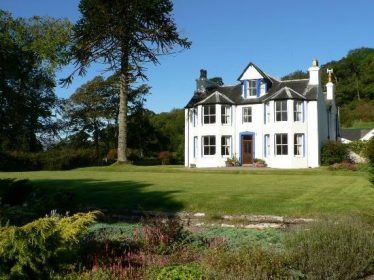
The Hodgson’s Scottish holiday home from the early 1900s
Henry and his family had started to holiday in the Highlands in the 1880s, following the example of the Lawes family, their cousins. After renting a number of houses in Argyllshire (including Achnacone – see Comment below), in the early 20C Henry rented, and then bought, Cuilcheanna in Onich, which was inherited by Victor. For the past fifty years this has been a guest house. http://www.cuilcheanna.co.uk/.
She had a deep love for Scotland, shared in particular by her son (Charles) Victor. It was said that the tragic death of her youngest son, Nigel Linnhe Tylston, a curate at Leeds Parish Church accidentally shot while watching manoeuvres of Leeds Rifles in 1909, had affected her deeply. In 1908 Henry had built a substantial house for her use, designed by Victor, known as ‘Rosemary’, in Milton Road, but she never lived there. At the outbreak of war in 1914, he made this house available as a military hospital/nursing home which was in use on and off during the war years. The Institute was likewise used as a nursing centre.
Henry’s death on 22 May 1918 was sudden and tragic. His daughter Mabel Paine found him at 3.10 pm in the lavatory at Welcombe, having shot himself. He had had bad sciatica for the previous three weeks, and had been in dreadful pain. Dr Blake was called, but Mr Hodgson was dead when he arrived. At the inquest Dr Lovell Drage was the district coroner and Captain Arthur Lydekker JP was the foreman of the Jury. Mrs Paine said that she had been staying with her father for some weeks. She last saw him at 3 pm when she had gone upstairs to rest. He had been getting up for a few hours for the past few days, and seemed to be getting better. He had had no worries except the worries everyone had – the strain of the war. “We all thought he was doing too much”. Dr Blake said this too. Dr Drage refused to allow a verdict of temporary insanity. He said it would reflect on the family for many years, mentioning insurances. So the jury returned a verdict of “shot by persons unknown” instead.
The funeral was on Saturday, 25 May at 3.30 pm. It was the largest funeral in Harpenden for many years past. Business premises were closed, and blinds drawn everywhere in a general manifestation of sorrow. “He was a man of sterling integrity and character who will be most missed of any man who has died in Harpenden” as a leading resident put it. The Herts Advertiser also described it as a “real personal and general loss” on all hands. Hundreds of people unable to obtain admission to the church were assembled for the closing scene. By special request of the family there were no wreaths.
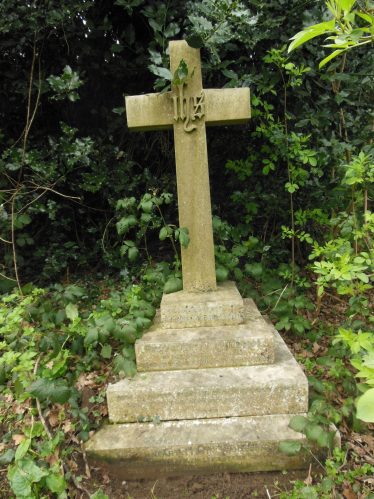
Memorial to Henry & Charlotte Tylston Hodgson in St Nicholas churchyard, Harpenden
At Mr Hodgson’s wish, his remains were conveyed to Golders Green in the morning and cremated, and the ashes were brought back to Harpenden pending the service in St Nicholas Church and interment in the graveyard. The local press reported that the following members of the Household were present: Messrs Bentley, C Sibley, Dellar and House, Misses Emily Day (see Comment below) and Friend and Mrs Dellar. Of the family, three were unable to attend: Aubrey (of Hemel Hempstead) was in America, Gerald (of Bennetts) was indisposed and Hubert, Captain in the Royal Engineers, was serving in France. Eustace (of London), Victor (Lt. RNR), Oswald (Commander RN) and Mrs Mabel Paine of Great Melton, Norfolk were there.
So were colleagues from the Midland Railway in Derby. Mr Murray Smith, Sir Ernest Paget and Mr Behrens, together with the General Manager of The Glasgow & South Western Railway, Mr D Cooper, arrived at 2.36 pm in a special saloon, the mid-day fast train from Derby pulling up at Harpenden to enable them to alight. They left again in the same special saloon attached to the 4.05 pm train from London, which stopped at Harpenden station for the purpose.
See Henry and Charlotte’s children for the continuation of the Hodgson family in Harpenden

Comments about this page
A short obituary of the Rev Commander Oswald Tylston Hodgson, dated February 1937, has just come to light in our archives. It gives more details of his WWI service and his work in North West Canada.
“Instead of following his brothers to Harrow, he entered the Royal Navy at the age of 14 and rose to be Commander. After six months in hospital in 1914, he was posted to Great Yarmouth, where he took charge of the fishing and mine-sweeping operations until the end of the war.
“After his retirement from the Navy, he volunteered for lay work in the North-West of Canada, and was ordained in 1924. For a time he was curate at St Mary’s, Bedford, but, returning to the North-West of Canada he took charge of Telegraph Creek, where he worked under arduous conditions.
“During his many years’ sojourn in arctic surroundings, Commander Hodgson built a wooden church, with a wooden hut for a Vicarage.”
This information has been incorporated into the page on the Hodgson family.
Gerald T Hodgson lived at Tullimaar, Perranarworthal in Cornwall (a house with a remarkable history) and had a long friendship with the family of Rowena Cade (builder of the Minack Theatre) at Porthcurno where he persuaded them to live as “Red Indians” during the summers of the late twenties. Contact info@minack.com for details and photos.
A curious might-have-been!
Reading about Luton Hoo and the Walled Garden after our group visit in September 2014, I discovered that Charlotte Hodgson’s father, Charles Warde, nearly bought Lutoo Hoo.
According to Felicity Brimblecombe’s research, “in 1844 he contracted to buy Luton Hoo for £150,000 and paid a deposit of £5000 but he never completed the payment. As far as I have found out he was trying to sell his Clopton House in Warwickshire to fund the purchase but there was, I think, a marriage settlement regarding this property and presumably Marianne was not going to let her asset go!
“In 1844 Charles’ father assigned his assets in return for an annuity but despite this and another inheritance from his mother’s brothers in 1837 he didn’t manage to complete the purchase. In early 1847 the agent on the Luton Hoo estate was advertising the walled garden for rental and farm land too.
“In 1848 John Shaw Leigh bought the estate: ‘Mr. Warde paid a considerable part of the purchase money of the Luton Hoo estate, but before the whole had been paid, and before any conveyance had been made to him, he, in 1847, contracted to sell that estate to Mr. [John Shaw] Leigh for 157,000L.’ The sale therefore was also between Leigh and [Lord] Bute as Warde didn’t actually own it!”
This was happening at the time that Marianne learned about Charles infidelities and returned to her brother in Harpenden. The acrimonious divorce took place in 1847. Charlotte was 5 at the time.
Charles did appear to have been interested in the plant collections in the gardens.
Mel Skeet came across Aubrey Hodgson as a result of local history research in the area near her home in Colchester when she found Achnacone Drive had been built on the site of Achnacone House – demolished in the early 196Os. She found that the most flamboyant and newsworthy owner of Achnacone was William Henderson Mackenzie, first husband of Emma Kirby, who then married Aubrey Tylston Hodgson after her husband’s untimely death.
From her research into the Mackenzie family of Achnacone House, Colchester (see her Comment above), it would appear that Aubrey Hodgson and William Henderson Mackenzie may have met as students possibly at Downton (agricultural) College, Wiltshire. By the 1891 census Aubrey was resident as as a companion/secretary at Achnacone House, the estate William Mackenzie had purchased from the Reverend Cato in 1889, possibly with wealth inherited from his grandfather, a major Essex landowner. The house had previously been known as Summerhill, and there seems to be a possible Hodgson connection to the change of name.
Before finally choosing Cuilcheanna House in Onich as the family Highland home, Henry Hodgson had rented Achnacone House in Argyllshire from the 12th Laird of the Stewarts of Appin. The younger Hodgsons published private Achnacone ‘newspapers’ recounting their holiday activities – a sample manuscript from September 1891 survives in the Hodgson/Paine archives. It seems possible that William Mackenzie had visited the Hodgsons there, and subsequently renamed his house after it. Aubrey and William were good friends who lived ‘fast’ – there are mentions of some of their escapades in the local Essex press. Following William’s early death, Aubrey married his widow, Emma Evelyn nee Kirby. The Essex County Chronicle of 5 February 1897 reported on their quiet marriage at St George’s, Hanover Square and then at Langham Hotel in London, attended by Emma’s son Sam MacKenzie in Highland dress. For a while they continued to live at Achnacone House, before selling it and moving to Highfield House in Hemel Hempstead (now converted into flats). During the 1914-18 war Aubrey worked with the Remount Commission in the US or Canada – an organisation for purchasing horses for the British Army to replace those killed in action – which is why he was unable to attend his father’s funeral. He died in Sussex in 1932.
Among the mourners at Henry Tylston Hodgson’s funeral was Miss Emily Day. An undated cutting in the Local History archives with the the headline “Link with Old Harpenden Broken by Death of Miss Emily Day”, describes how she left her family home at 19 Cross Street, Harpenden (Bowling Alley) “at an early age to enter the service of the late Mr Henry Tylston Hodgson as housekeeper at The Welcombe”. She held “a similar position at Cuilcheanna, Onich, Fort William which belonged to the late Mr Victor Hodgson” and stayed on with Mrs Victor Hodgson until her retirement – ten years before her death at the age of 78. “She had, in fact, spent the whole of her working life with Hodgson family and was affectionately regarded as one of the family.” As well as members of her own immediate family, others present included “Mrs Paine, only daughter of the late Mr Tylston Hodgson and her son, Rev. Humphrey Paine.”
I have references to some newspaper articles which mention Aubrey Tylston Hodgson in connection with his employment as secretary to William Henderson Mackenzie. Aubrey later married William Henderson Mackenie’s widow.
Ed. We’d love to hear more.
Add a comment about this page